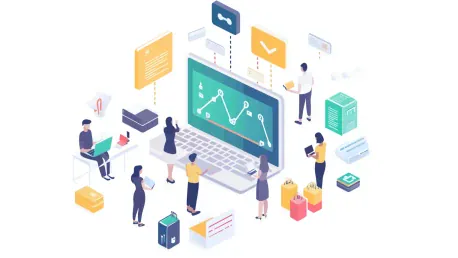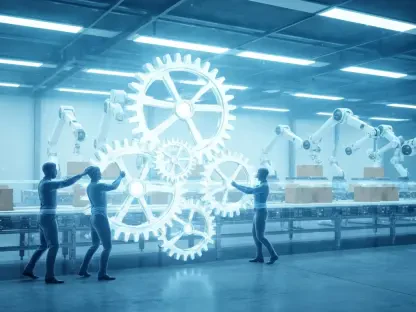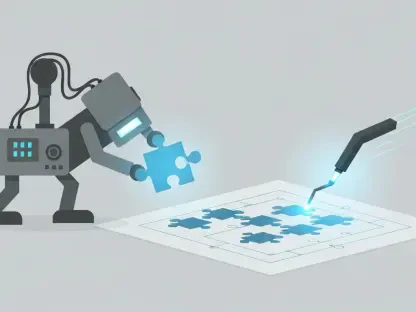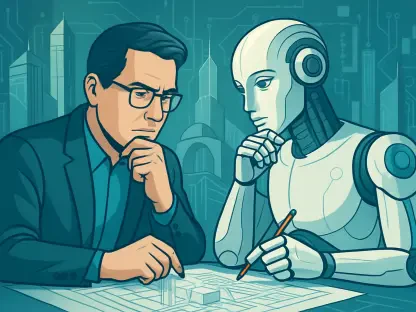Artificial intelligence (AI) is revolutionizing traditional service-based industries by automating and digitizing complex tasks. This transformation, known as “Services as Software,” is reshaping how enterprises operate, driving efficiency, cost reduction, and innovation. The sweeping changes brought about by AI are poised to redefine the way businesses function, pushing the boundaries of what technology can accomplish in service delivery and operations.
The Traditional Landscape of Technology Services
Human-Led Services
For decades, technology services relied heavily on human labor. Programmers, analysts, system integrators, and consultants manually managed and optimized business operations. This conventional model required significant human intervention for various tasks. Professionals would spend countless hours troubleshooting, configuring systems, and ensuring everything ran smoothly. This hands-on approach, while effective, was often time-consuming and costly, demanding a large workforce with specialized skills. The reliance on human expertise also meant that the services were prone to human errors and inefficiencies.
The traditional landscape of technology services has always been labor-intensive. Businesses had to hire skilled professionals to handle everything from data entry to complex system integrations. The process was not only slow but also costly, as human labor comes with high overheads. These services were also limited by human capabilities, with the speed and accuracy of work often varying from person to person. As a result, enterprises faced challenges in scaling operations and maintaining consistency in service quality. This landscape, however, was on the cusp of a significant transformation with the advent of AI technologies.
The Advent of AI
With the rise of AI, this traditional approach is undergoing a fundamental shift. AI-driven tools are now capable of automating tasks that were once considered too complex for machines, marking a new era in service delivery. Tasks such as data analysis, system configuration, and even customer interactions are being taken over by sophisticated AI algorithms. These tools are designed to learn from data, make predictions, and execute tasks with minimal human intervention. The advent of AI means that businesses can achieve higher efficiency and accuracy in their operations, significantly reducing the need for extensive human involvement.
The introduction of AI into the technology services sector has brought about profound changes. AI systems can analyze vast amounts of data in a fraction of the time it would take a human, providing insights and recommendations that are both accurate and actionable. This capability allows businesses to make data-driven decisions quickly and effectively, which was challenging in the traditional setup. Moreover, AI’s ability to continuously learn and improve means that the quality and efficiency of services are constantly evolving. This shift is setting the stage for the emergence of a new paradigm in technology services, where AI-driven solutions are at the forefront of innovation and operational efficiency.
The Emergence of ‘Services as Software’
From SaaS to AI-Driven Solutions
The concept of Software-as-a-Service (SaaS) revolutionized enterprise IT by replacing on-premise software with cloud-based solutions. ‘Services as Software’ takes this evolution further, enabling software to autonomously execute tasks traditionally performed by humans. While SaaS simplified the deployment and management of software by moving it to the cloud, ‘Services as Software’ integrates AI to automate service delivery. This means that not only is the software hosted remotely, but it also becomes self-sufficient in performing operational tasks. The role of human workers is shifting from performing routine tasks to overseeing AI systems and making strategic decisions based on AI outputs.
The transformation from SaaS to AI-driven solutions is a significant leap in how enterprises approach technology integration. Unlike SaaS, which primarily focused on providing accessible software via the cloud, ‘Services as Software’ embeds AI capabilities within these platforms. For instance, AI can process customer service queries, automate financial transactions, and even manage IT infrastructure without human intervention. This shift is not merely about software delivery but about empowering software to function as autonomous agents. The result is a more efficient, cost-effective, and scalable model of service delivery that can adapt to the dynamic needs of modern enterprises.
Impact on Enterprise IT
This shift is creating a new paradigm where AI tools replace not just the software used by humans but the human roles themselves. Enterprises are rethinking their workflows, integrating AI to enhance efficiency and reduce costs. AI tools are being deployed to handle a wide range of tasks, from routine customer inquiries to complex data analysis and decision-making processes. This transformation means that many roles traditionally filled by human workers are now being reassigned to AI-driven systems, freeing up human resources for more strategic and creative tasks. The impact on enterprise IT is profound, as businesses can operate more smoothly and efficiently with fewer human interventions.
The integration of AI into enterprise IT is also driving innovation. Businesses are exploring new ways to leverage AI capabilities to gain a competitive edge. For example, AI can predict market trends, optimize supply chains, and even personalize customer experiences at scale. These advancements are making enterprises more agile and responsive to changes in the market. Additionally, the cost savings from reduced labor and increased efficiency are enabling firms to reinvest in new technologies and growth opportunities. This AI-driven transformation is not just a trend but a fundamental reengineering of how enterprises leverage technology to achieve their strategic objectives.
Industry-Specific Transformations
Legal and Compliance Sector
In the legal industry, AI tools like Harvey AI are revolutionizing legal research and brief generation. These tools are effectively replacing human research assistants, streamlining legal processes. By utilizing natural language processing and machine learning algorithms, AI can sift through vast volumes of legal texts, case laws, and statutes in seconds, a task that would take a human researcher weeks or even months. The accuracy and speed of these AI tools are unparalleled, allowing legal professionals to focus on strategic aspects of their work rather than spending time on rote, labor-intensive tasks. This not only increases productivity but also improves the quality of legal services.
The use of AI in the legal sector extends beyond research. AI is being used to draft contracts, assess risks, and even predict the outcomes of litigation. These capabilities are transforming how law firms operate, making them more efficient and effective. AI tools can identify potential legal risks in contracts and provide recommendations for mitigating those risks, tasks traditionally performed by highly skilled and expensive legal professionals. This democratization of legal expertise means that even smaller firms can access high-quality legal tools, leveling the playing field. The legal industry, once slow to adopt new technologies, is now at the forefront of the AI revolution, reaping the benefits of increased operational efficiency and reduced costs.
Customer Service Revolution
AI chatbots and virtual agents are transforming customer service. For example, Bank of America’s Erica AI handles millions of customer interactions, significantly reducing the need for human agents. These AI-driven tools are capable of handling a wide range of customer inquiries, providing instant responses and solutions. The use of AI in customer service not only enhances the customer experience by providing quick and accurate responses but also allows businesses to operate more efficiently by reducing the number of human agents needed. This transformation is particularly beneficial for large organizations that handle vast volumes of customer interactions daily.
The revolution in customer service driven by AI is not limited to chatbots. Advanced AI systems can analyze customer data to provide personalized services, predict customer needs, and even identify potential issues before they arise. This proactive approach to customer service enhances customer satisfaction and loyalty. Moreover, AI tools can operate 24/7, providing uninterrupted service and support, something that is not possible with human agents. This round-the-clock availability is crucial in a globalized economy where customers expect swift responses regardless of time zones. The integration of AI in customer service is setting new standards for efficiency and customer satisfaction, making it a vital component of modern business strategies.
AI’s Role in Software Development and Data Analysis
Automating Coding Tasks
AI tools such as GitHub Copilot and Cognition AI’s Devin are automating complex coding tasks. This reduces the need for extensive engineering teams, making software development more efficient. AI-driven tools can generate code snippets, debug existing code, and even suggest improvements, significantly speeding up the development process. This automation allows developers to focus on more complex and creative aspects of software development, enhancing overall productivity. The ability of AI tools to understand and write code is revolutionizing how software is developed, maintained, and updated, making the process faster and more cost-effective.
The role of AI in software development is expanding rapidly. These tools are not only assisting in coding but also in project management and software testing. AI can predict project timelines, identify potential bottlenecks, and allocate resources efficiently. In software testing, AI tools can automatically identify bugs and vulnerabilities, ensuring higher quality and more secure software. This comprehensive approach to software development reduces the risks associated with human errors and inconsistencies. The integration of AI in the software development lifecycle is transforming how development teams operate, enabling them to deliver more robust and reliable software solutions faster than ever before.
Enhancing Data Analysis
In data analysis and business intelligence, tools like OpenAI’s Code Interpreter are automating tasks that previously required manual effort. This transformation allows businesses to gain insights faster and more accurately. AI-driven data analysis tools can process large datasets, identify patterns, and provide actionable insights within minutes. This capability is crucial in today’s data-driven world, where timely and accurate information is key to making informed business decisions. By automating data analysis, businesses can respond more quickly to market changes, optimize their operations, and gain a competitive edge.
The impact of AI on data analysis goes beyond speed and accuracy. AI tools can uncover hidden insights and correlations that might be missed by human analysts. These insights can lead to innovative strategies and solutions that drive business growth. Additionally, AI-driven data analysis tools can continuously learn and improve, adapting to new data and evolving business needs. This adaptability ensures that businesses are always equipped with the most relevant and accurate information. The integration of AI in data analysis is transforming how businesses operate, enabling them to leverage data in ways that were previously unimaginable.
Rethinking Enterprise Workflows
Redefining Business Processes
The AI-driven shift is compelling enterprises to rethink their fundamental workflows. Companies are redesigning processes around AI capabilities, automating tasks that were previously outsourced to human agencies. This shift is not just about replacing human labor with AI but about creating more efficient and adaptive business processes. Enterprises are leveraging AI to streamline operations, enhance productivity, and reduce operational costs. For example, in marketing, AI tools can automate campaign management, analyze customer behavior, and optimize ad spend, tasks that would typically require a team of marketing professionals.
By redefining business processes around AI capabilities, companies can achieve a level of operational efficiency that was previously unattainable. AI can handle repetitive and time-consuming tasks with ease, allowing human employees to focus on more strategic and value-added activities. This reconfiguration of workflows is leading to significant cost savings and improved performance across various business functions. Moreover, AI’s ability to learn and adapt means that these processes are continuously optimized for better outcomes. The integration of AI into business processes is not just a technological upgrade but a fundamental transformation that is reshaping the future of enterprise operations.
Addressing Talent Challenges
As the Baby Boomer generation retires and traditional cross-border talent flows are disrupted, enterprises are turning to AI to address these challenges. AI helps mitigate talent churn and supports operational continuity. The labor market is facing significant changes, with a large portion of the workforce reaching retirement age and geopolitical factors affecting the movement of skilled labor. These challenges are prompting businesses to seek alternative solutions to maintain productivity and operational efficiency. AI-driven tools are stepping in to fill the gaps, taking over tasks that were previously performed by experienced professionals.
The deployment of AI solutions is also addressing the skills gap in the workforce. As technology evolves, the demand for specialized skills is increasing, and businesses are finding it difficult to keep up. AI tools can reduce the dependency on specific skill sets by automating complex tasks and processes. This allows companies to maintain high levels of productivity and efficiency even with a reduced or less specialized workforce. The ability of AI to adapt and learn from data ensures that it can handle a wide range of tasks, making it a versatile solution for addressing talent challenges. This integration of AI is helping businesses navigate the evolving labor landscape and maintain operational continuity.
The Future of Human Labor
Evolving Human Roles
While AI is automating many tasks, human contribution remains essential in areas like AI oversight, creativity, and strategic thinking. The nature of work is changing, requiring new skills and adaptation. As AI takes over routine tasks, human workers are being freed up to focus on more complex and strategic activities. This shift is creating new opportunities for human workers to engage in roles that require critical thinking, creativity, and emotional intelligence – qualities that AI systems currently lack. Workers will need to adapt by developing new skills and embracing the collaborative potential of working alongside AI systems.
The evolving role of human labor in an AI-driven world is not about competition but collaboration. Humans and AI systems are complementing each other’s strengths, creating more efficient and innovative work environments. For instance, in healthcare, AI can analyze medical data and suggest diagnoses, but human doctors are needed to interpret these suggestions and provide a holistic treatment plan. Similarly, in creative industries, AI can generate content ideas and streamline production processes, but human creativity and insight are crucial in crafting compelling narratives. This collaborative future is redefining the workforce, with AI enhancing human capabilities and unlocking new potential for innovation and growth.
Collaborative Future
Artificial intelligence (AI) is dramatically transforming traditional service-based industries by automating and digitizing a myriad of complex tasks. This significant shift, often referred to as “Services as Software,” is fundamentally changing how enterprises operate. By integrating AI, companies are seeing increased efficiency and substantial cost reductions, all while fostering innovation. Tasks once handled manually are now performed with greater speed and precision, thanks to AI technologies.
AI’s ability to streamline operations means that businesses can focus more on strategic growth and less on mundane processes. This evolution allows companies to reallocate resources towards enhancing customer experiences and developing new services. Moreover, AI-driven analytics provide deep insights into customer behaviors and operational performance, enabling smarter decision-making and personalized service offerings.
The sweeping changes brought about by AI are set to redefine the business landscape further. Automation and AI are pushing the boundaries of what technology can achieve in service delivery and operations, making it possible to tackle challenges previously deemed too complex or time-consuming. As AI continues to evolve, its role in transforming industries will only become more pronounced, signifying an era where services are not just enhanced but fundamentally reimagined. This new paradigm, where software and intelligent systems take the lead, helps businesses stay competitive in an ever-changing market.









